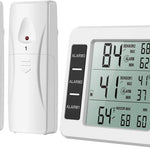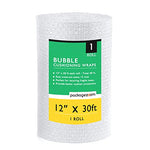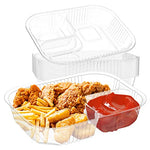You have no items in your shopping cart.
Welcome to our in-depth guide on the critical topic of when food workers are required to change gloves. Proper glove usage is paramount in maintaining food safety and preventing cross-contamination. As a food worker or someone interested in food safety practices, understanding the guidelines and best practices surrounding glove changes is essential.
In this article, we will delve into various scenarios and requirements for glove-changing, as well as provide insights based on first-hand knowledge and credible sources. So, let's embark on this journey of knowledge and ensure the highest standards of food safety are met.
Click Picture To View Price on Amazon
Understanding the Importance of Proper Glove Usage
Gloves serve as a protective barrier between food handlers and the items they handle. The proper use of gloves is crucial in preventing the spread of harmful bacteria and viruses, ensuring the safety of both the food workers and the consumers. Let's explore when food workers are required to change gloves to maintain optimal food safety.
The Key Scenarios for Changing Gloves
Before Handling Different Food Items
One of the essential instances when food workers must change gloves is before handling different food items. This is especially critical when transitioning from raw to cooked items. For example, if a worker has been handling raw meat, they should change gloves before touching ready-to-eat items such as salads or desserts. This practice significantly reduces the risk of cross-contamination and foodborne illnesses.
After Handling Contaminated Surfaces
Food workers should promptly change gloves after touching any potentially contaminated surfaces, such as money, cleaning equipment, or trash bins. These surfaces may harbor harmful pathogens that can easily transfer to food items if gloves are not changed. Being vigilant in changing gloves after contact with such surfaces is a fundamental step in maintaining food safety.
When Gloves Are Torn or Damaged
Gloves can sometimes tear or become damaged during food handling tasks. If a food worker notices any damage to their gloves, they must change them immediately. Even small tears or punctures can compromise the integrity of the gloves, rendering them ineffective in protecting against contamination. Regularly inspecting gloves for any signs of damage is essential in ensuring their efficacy.
After Engaging in Non-Food Related Activities
Food workers should avoid performing non-food related activities while wearing gloves. Tasks like answering phone calls, handling personal items, or adjusting equipment should be done without gloves. Changing gloves after engaging in such activities helps prevent the transfer of contaminants from external objects to the food.
When Moving Between Different Food Preparation Areas
Food establishments typically have designated areas for different food preparation tasks, such as raw meat handling and vegetable preparation. Food workers must change gloves when moving between these areas to prevent cross-contamination. This practice is particularly crucial in establishments that handle allergens, as cross-contact with allergens can have severe consequences for allergic individuals.
When Switching Between Tasks
Food workers should change gloves when switching between different tasks, even if they involve handling the same type of food. For instance, if a worker is slicing vegetables and then moves on to seasoning a dish, changing gloves is necessary. This precaution ensures that any potential contamination from the previous task does not carry over to the next one.
Click Picture To View Price on Amazon
Best Practices for Proper Glove Changing
Changing gloves properly is just as important as knowing when to change them. Following these best practices ensures that the glove-changing process is effective in maintaining food safety:
Step 1: Wash Hands Thoroughly
Before putting on new gloves, food workers must wash their hands thoroughly with soap and water. Proper handwashing is crucial in removing any potential contaminants and helps maintain a hygienic environment.
Step 2: Remove Gloves Carefully
When removing gloves, it's essential to do so carefully to avoid any contact between the outside of the gloves and the skin. Pinch one glove at the wrist and peel it off, turning it inside out as it is removed. Then, use the inside-out glove to pinch the other glove's wrist and peel it off in the same manner.
Step 3: Dispose of Gloves Properly
Disposed gloves should be placed in designated trash containers immediately after removal. Never reuse disposable gloves, as doing so can lead to contamination.
Step 4: Wash Hands Again
After removing gloves, food workers should wash their hands again to ensure that any potential contaminants are thoroughly eliminated.
Explore our premium selection of trash bags designed to meet all your waste disposal needs. Whether you're looking for durable kitchen trash bags or heavy-duty options for industrial use, we've got you covered. Click the green button to discover high-quality bags that combine strength and reliability. Make your waste management hassle-free with our top-notch collection.
Frequently Asked Questions (FAQs)
Q: When should food workers change gloves during peak hours in a restaurant?
A: Even during busy hours, food safety remains a top priority. Food workers should change gloves following the same guidelines, such as before handling different food items or after touching contaminated surfaces, to maintain optimal food safety.
Q: Are there specific types of gloves recommended for food handling?
A: Yes, food-safe disposable gloves made of nitrile, latex, or vinyl are commonly used in the food industry. These materials offer the necessary barrier protection and flexibility for food handling tasks.
Q: How often should food workers inspect their gloves for damage?
A: Food workers should inspect their gloves regularly, ideally every hour or after performing tasks that might have exposed the gloves to potential damage.
Q: Can hand sanitizers replace handwashing before glove use?
A: Hand sanitizers are not a substitute for proper handwashing. Food workers must wash their hands with soap and water before wearing gloves to ensure thorough cleanliness.
Q: Is glove-changing necessary when handling pre-packaged and ready-to-eat foods?
A: Yes, glove-changing is still necessary, even when handling pre-packaged and ready-to-eat foods. This practice helps prevent potential contamination from external surfaces or previous handling tasks.
Q: How can food establishments enforce proper glove usage among their employees?
A: Training programs, routine inspections, and setting a positive example through management are effective ways to encourage and enforce proper glove usage in food establishments.
Conclusion
Ensuring the proper changing of gloves is a crucial aspect of maintaining food safety in any food handling environment. By following the guidelines and best practices outlined in this article, food workers can significantly reduce the risk of cross-contamination and foodborne illnesses. Remember always to prioritize hygiene, follow proper handwashing techniques, and change gloves whenever necessary to protect both customers and yourself.
15 Gallon - Tall Kitchen Bags

Introducing our 15 Gallon Tall Kitchen Bags! These bags are perfect for everyday kitchen waste and feature a strong and reliable design.
- Capacity: 15 gallons
- Dimensions: 15" x 9" x 30"
- Designed for kitchen use
- Resistant to tears and leaks
"These bags have made my kitchen cleanup a breeze. Highly recommend them!"
- Emily Jarred
"I've been using these bags for months now, and they never disappoint. Great quality!"
- Michael Anderson
39 Gallon - Heavy-Duty Trash Bags

Introducing our 39 Gallon Heavy-Duty Trash Bags! These bags are perfect for handling larger loads of trash and are built to resist tears and leaks.
- Capacity: 39 gallons
- Dimensions: 23" x 10" x 39"
- Heavy-duty construction for extra strength
- Thick material to prevent leaks
"These bags are the best I've ever used. They can handle even the toughest trash."
- Lewis Martinez
"I'm impressed by the durability of these bags. They never fail to hold up, even when filled to the brim!"
- Jessica Roberts
33 Gallon - Heavy-Duty Trash Bags

Introducing our 33 Gallon Heavy-Duty Trash Bags! These bags are designed to handle heavy loads of trash, making them ideal for residential and commercial use.
- Capacity: 33 gallons
- Dimensions: 23" x 17" x 46"
- Extra-strong construction for durability
- Thick material to prevent leaks
"I've never had a bag that could handle so much trash. These bags are a game-changer!"
- Samantha Turner
"I run a small restaurant, and these bags are perfect for our needs. They're strong, reliable, and affordable!"
- David Patterson
55 Gallon - Contractor Trash Bags

Introducing our 55 Gallon Contractor Trash Bags! These bags are designed to handle heavy, bulky trash and are commonly used in construction and renovation projects.
- Capacity: 55 gallons
- Dimensions: 22" x 16" x 55"
- Heavy-duty construction for demanding tasks
- Durable and tear-resistant
"These bags are an absolute lifesaver on our construction sites. They can handle anything we throw at them!"
- Mark Thompson
"I've used many different contractor bags, and these are by far the best. They never let me down!"
- Rachel Collins












![100% Compostable 9 Inch Paper Plates [125-Pack] Heavy-Duty, Natural Disposable Bagasse Plate, Eco-Friendly Made of Sugarcane Fibers - Natural Unbleached Brown 9" Biodegradable Plate by Stack Man](http://www.trashrite.com/cdn/shop/products/418LbW6FSUL_150x150_crop_center.jpg?v=1689802541)
